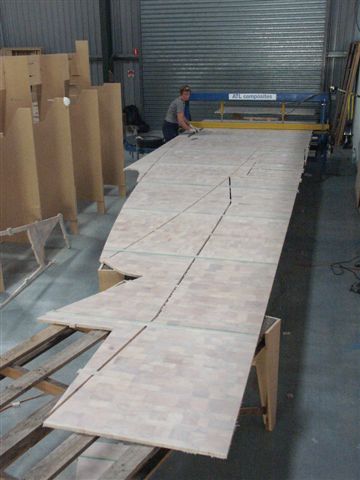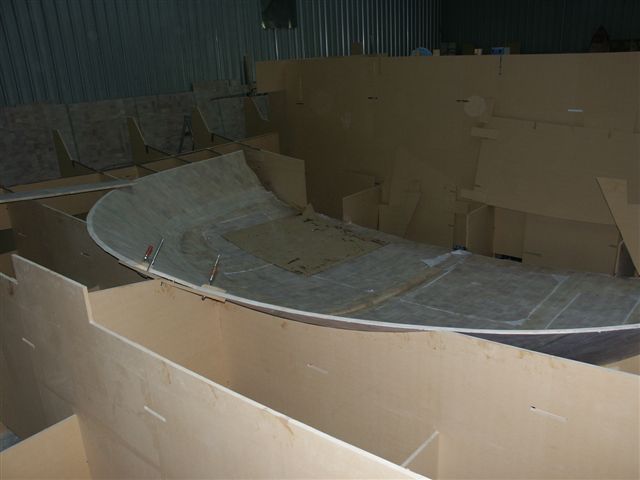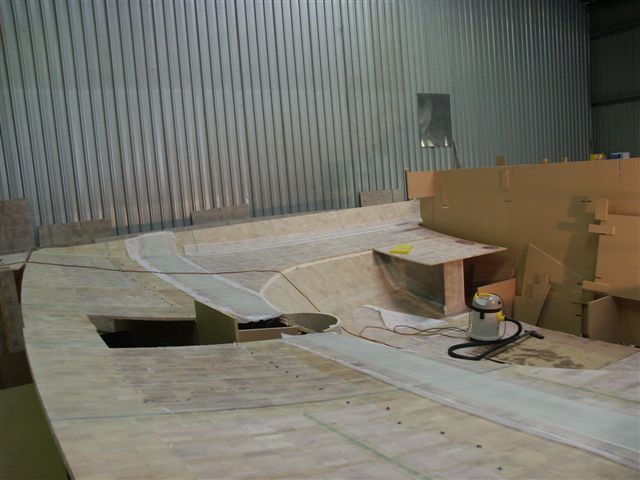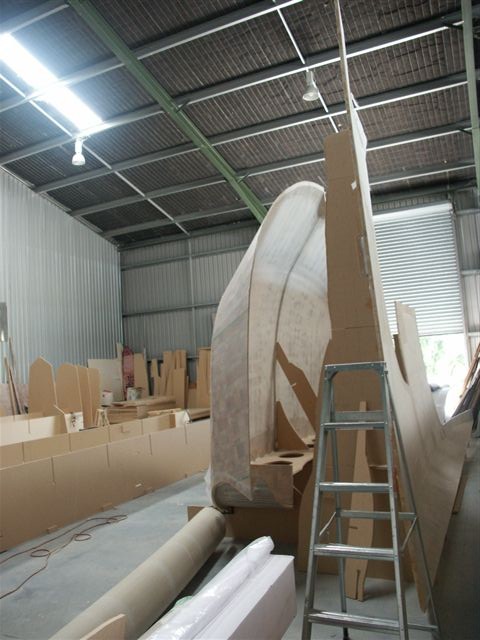 1st delivery May 2003
1st delivery May 2003
At the start, a shed with pallets of building material.... so we got some parts to join here:
For the non boat bulding people:
- we receive composite panels of glassed balsa that are pre-routed according to the boat plans
- then we join them to long planks and cut the parts out
 panel joining May 2003
panel joining May 2003
The panels are joined (glued with epoxy) using a heated hydraulic press to speed things up. All boat parts could be joined within roughly a week like this. (without the press the joins would need to cure over night - in the press they cure within 15 minutes) We join just the deck parts because there would be no space to store all planks.
The first thing we build are the decks, building them upside down, that saves us from later glueing, sanding and fairing over our heads. At the moment it takes the pleasure of quick visible progress from us, as what we build doesn't look like a boat.
Here we've put up the deck frames (front part bow to cockpit).
 deck frames May 2003
deck frames May 2003
The frames are used to bring the parts joined earlier into the required shape ( they are all just flat planks so far) and to assemble them to bigger pieces.
Some parts, e.g. the coachroof have too much different curves in them to use this technique at all, they are strip planked:
 coachroof June 2003
coachroof June 2003
then gradually the decks parts are growing on the frames:
The composite material does not really bend. To achieve curves like this we use curve cuts (cut the inner skin of the composite planks until they're flexible enough to fit onto the frames and fill the cuts with glue. Let the glue cure in with the part in the frames and it'll keep the shape. Then it needs glassing on the side with the cuts to re-produce the material strength.
 coaming June 2003
coaming June 2003
To cut a long story short, one day even the slowest boat builder has a complete deck
 decks
July 2003
decks
July 2003
and can sit on it (still upside down) and dream of the boat
 decks
Juny 2003
decks
Juny 2003
For the techis:
- The traversal glass visible in the middle is 6 layers of unidirectional glass (800g) to support the mast bulkhead
- All parts were curve cutted to get them into shape, with the coachroof strip planked
- the balsa core was replaced with marine ply where loaded hardware goes e.g. winches
- reinforcements for stanchions are glassed
Then we put it all aside and the shed is fresh to start on the hulls: Luckily there is a permanent crane in the roof of the shed.
 decks August 2003
decks August 2003
So this took 3 1/2 months - and still it doesn't look like a boat :-)
why does it take so long?
- mainly beause its really big (14,8m long)
- there is only two of us, sometimes 4 would be just good
- not everything works always out as planned, building a 'one off' always gives you the chance to do some troubleshooting :-) next time you'll be faster
- we're not allowed to work on Sundays, it's a residential area ( not that we would do that anyhow)
- and believe it or not - this is roughly within schedule
and then there is visitors that come and interrupt us - they seem to have been in the shed well before us.
 friend
friend
 friend
friend